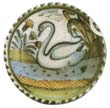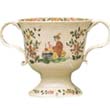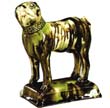Love it or hate it, the naivety of early English pottery leaves few indifferent to its charms and there are enough smitten collectors to make many of the rarest pieces extremely valuable. If you’re thinking of collecting, it’s helpful to learn the difference between the most important types.
During the late 17th and early 18th centuries, English pottery underwent a period of rapid development and an enormously varied range of wares and decorative techniques appeared. Such pottery is categorised by the type of material from which the body was made (such as earthenware, stoneware, creamware) and the type of glaze used (such as tin glaze or salt glaze).
Below are six types of pottery made before c.1770 (for post-1770, see Later English pottery) as well as pointers on which pieces you can expect to see and which are most sought after.
Slipware

Made from red or buff earthenware and decorated with white or coloured slip (diluted clay). Zig-zag, feathered and marble designs predominate. Produced in Staffordshire, Wrotham in Kent, Bideford, Barnstaple, Wales, Wiltshire and Sussex. Dates from 17th to mid-18th century.
What to look for: dishes and mugs; named or dated wares, especially those of best-known maker Thomas Toft, who occasionally signed his wares on the front (no marks usually). Beware of skilful fakes.
English delft

Made from tin-glazed earthenware in Southwark, Lambeth, Bristol and Liverpool. Primitive designs of figures, animals and floral subjects mainly painted in blue, white, yellow, green and manganese. Known as ‘delftware’ from Georgian times. Dates from mid-16th to late-18th century.
What to look for: blue-dash chargers (plates with blue strokes around the edge, as in the picture; often decorated with monarchs); barbers’ bowls; pill slabs; flower bricks. Chips are acceptable. Not marked.
Saltglaze stoneware

White Devon clay and powdered flint were added to earthenware to make lightweight white wares; salt thrown in the kiln during firing formed a glaze pitted like the skin of an orange. After c.1745 more use of famille rose-type enamel colours to imitate Chinese porcelain. Made in Staffordshire from mid-18th century.
What to look for: figures and pew groups (very rare); loving cups; mugs; plates; jugs formed as owls; unusually shaped teapots (camels, houses). Usually no marks.
Wheildon

Mid-18th century Staffordshire potter Thomas Wheildon developed lead-glazed pottery for tablewares and figures. Colours were limited to olive-green, brown, grey and blue.
What to look for: well-modelled animals such as this dog; unusually shaped wares; candlestick figures; cow creamers; cottages with figures. Tablewares are less expensive. Never marked.
Agateware

Layers of differently coloured clays rolled together, then sliced to build up mingled layers resembling agate and moulded into wares. Lead and salt glaze were variously used. Made in Staffordshire during the 18th century.
What to look for: cats, as shown; teawares, jugs, coffee and chocolate pots; shell-shaped wares, inspired by contemporary silver; pieces with more than two different-coloured clays. Never marked.
Creamware
Coloured earthenware with transparent lead glaze, developed by Wedgwood in the 1760s. Also made in other Staffordshire potteries and in Leeds, Bristol, Liverpool, Swansea and Derby. May be enamelled, plain or pierced.
What to look for: red and black enamelling by Robinson & Rhodes; wares marked ‘Wedgwood’; pierced wares, which may be marked ‘Leeds Pottery’; moulded pieces such as cruets and centrepieces. Few creamwares are marked.











